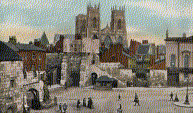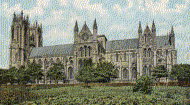Johannes LeCarter
of
Wodemanse Manor
Beverly, East Riding, County York, England
In The Year 1297
The first CARTER of whom there seems to be
official record is JOHANNES le CARTER, of Wodemanse Manor, in Beverly, a
town of the East Riding, County York, England, where he owned land which
brought him in a rental of two shillings, six pence. He is mentioned
first in a placita coram rege roll, in the Trinity term of the King's
court of County Kent, in the 25th year of Edward 1 (1297). He died
leaving issue:
A. JOHANNES le CARTER, married AGNES
B. WILLIAM le CARTER, married ELIZABETH
C. INGRAM le CARTER , and his wife MARGARETTA

 York, in County York, England
York, in County York, England
THE ORIGIN OF YORK
The Roman name for York was Eboracum, based on a native British name for the ancient site. It is thought that the root of the
early name was Eburos, an Ancient British personal name, which suggests that the site was founded by someone called
Eburos. An alternative view is that the name is based on the Ancient British word Eburos meaning Yew, a sacred Celtic tree
from which the personal name Eburos derives. In Roman times there was a Gaulish tribe called the Eburorovices, who were
the 'Warriors of the Yew Tree'.
When the Anglo-Saxons arrived in the north from Germany and Denmark in the sixth century they made Eboracum the capital
of Deira, a Northumbrian sub-kingdom. Eboracum was corrupted by Anglo-Saxon speech into Eoforwic meaning 'wild boar
settlement'. The Anglo-Saxons confused the Celtic word 'Ebor' meaning yew tree with their own word 'Eofor' meaning 'wild
boar'.
In 865 AD the Danes captured the North and in 876 Halfdene the Dane made Eoforwic the capital of the Viking Kingdom of
York . Later in 918 AD a mixed race of Norwegian-Irish Vikings settled at York and for many years York was subordinated
to the Viking stronghold at Dublin. Viking influence can still be detected in the street names of York, where the suffix 'gate' as
in Stonegate or Goodramgate derives from the Old Norse 'gata' meaning road or way. Stonegate follows the course of a
Roman road through the city and Goodramgate is named after Guthrum, a Viking leader.
The Vikings interpreted Eoforwic, the Anglo-Saxon name for York as Jorvik. The change of the Saxon f to a Viking V
occured in other words in the English language such as the Anglo Saxon word 'Seofan' which was changed by the Vikings
into its modern form 'Seven'. In the late Viking period it is thought that the name Jorvik was shortened to something
resembling its present form, York and in the medieval age the name York was generally used, although an independent form
'Yerk' is known to have existed at this time. One of the problems of studying York's name is that many early records are
written in Latin and thus use the Roman name Eboracum in periods when Eoforwic or Jorvik were used in every day speech.
Today the early forms of York's name are still well known and although the Viking Kingdom of York no longer exists, its
natural successor Yorkshire, 'the county of York' still takes its name from this ancient city.

 BEVERLEY
BEVERLEY
Beverley was once the capital of the East Riding of Yorkshire and is the home to Beverley Minster, regarded as one of the
most beautiful churches in England. In its architectural stature it is more of a cathedral than a church and indeed many English
cathedrals are overshadowed by Beverley. The first church, with an attached monastery was built at Beverley in the 7th
century by St John of Beverley who had trained under St Hilda at Whitby. In 687 AD he became the Bishop of Hexham
and later the Bishop of York.
John later returned to Beverley, where he retired and he was buried in his church. Later the Danes almost destroyed the
church but it was rebuilt and visited by King Athelstan in the tenth century, sometime before a great battle with the Vikings.
Pilgrims continued to flock to John's shrine and in 1037 he was canonized as a saint. In 1138 the saint's banner was carried
with the standards of other famous northern saints at the Battle of the Standard near Northallerton.
Sometime after the Norman conquest the church was refashioned by the Normans, but their new building was destroyed by
fire in 1188. Around 1220 rebuilding of a new minster church began and work continued until around 1420 culminating in the
magnificent church of today.
Inside the minster is an elaborate shrine to the Percy family (See also Alnwick) which was constructed in the fourteenth
century. Nearby is a Frid Stool or peace stool, a primitive seat of Anglo-Saxon origin which is similar to one found at Hexham
Abbey. The stool offered sanctuary to criminals similar to the sanctuary offered at Durham Cathedral. Beverley's organ is a
Snetzer organ, one of the best surviving examples, dating from 1767.
The town of Beverley grew up around the minster church and received its first charter in 1129. Beverley was incorporated as
a borough in 1573 during the reign of Elizabeth I. As well as the minster there are a number of other historic features in
Beverley worthy of note. The beautiful parish church of St Mary's, dating from the 12th century predates the minster and is
famous for a carving of a rabbit which is said to have inspired Lewis Carroll to create the March Hare in Alice in Wonderland.
Most of Beverley's town centre is Georgian and Victorian but at the northern entrance to the town is the medieval North Bar.
It was one of five gateways protecting the entrance to the town and was supported by a drawbridge, as Beverley was
surrounded by a defensive ditch. Beverley's Market Place is the home of a Saturday market and has a market cross dating
from 1714, which is supported with 8 columns. Horse racing has been held in Beverley since 1690.

BACK TO MAIN PAGE

